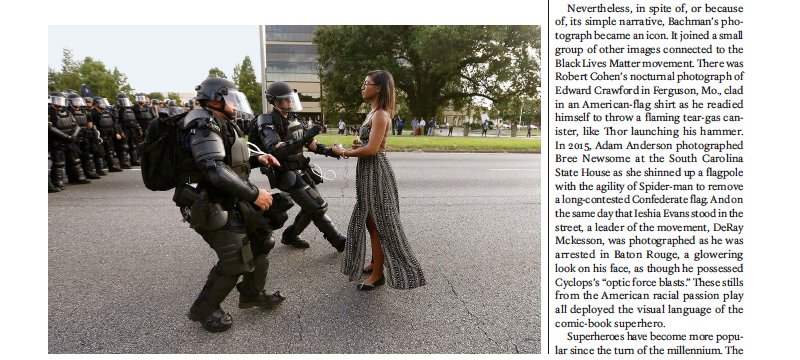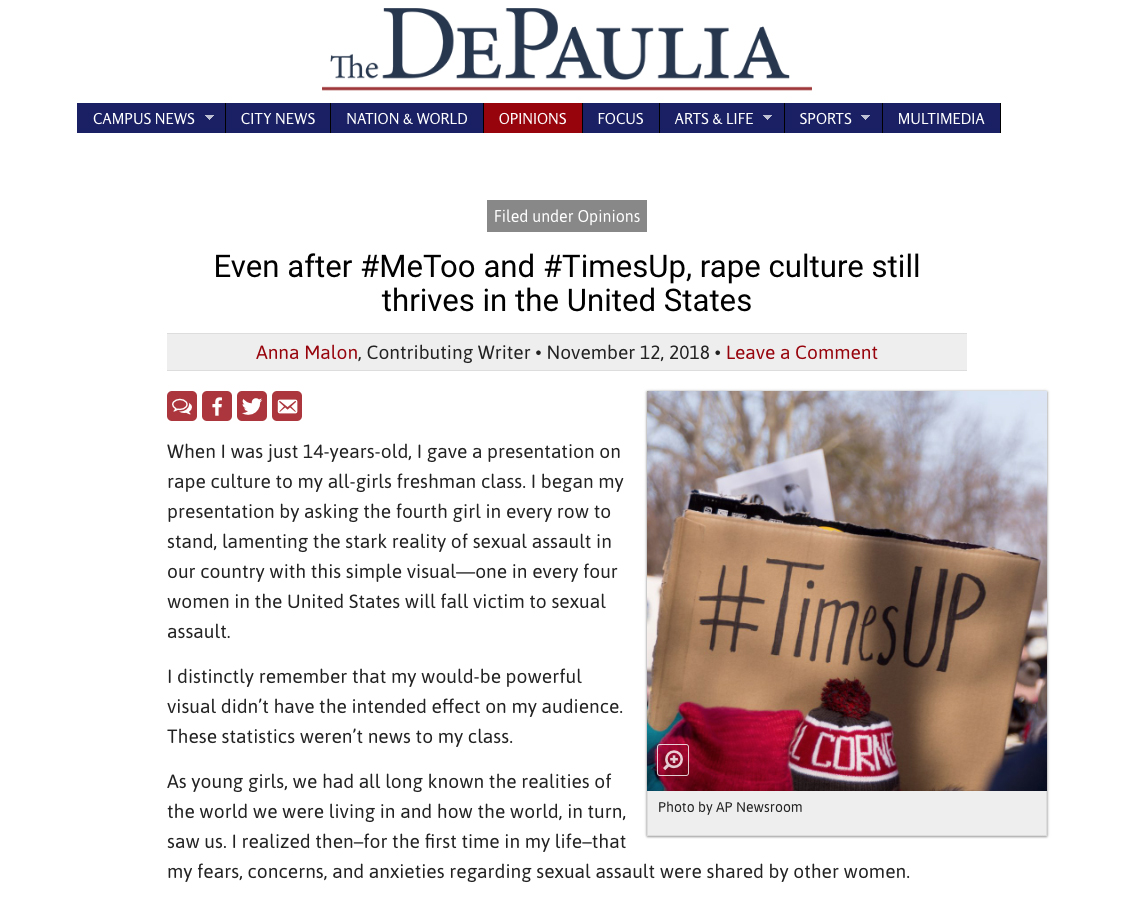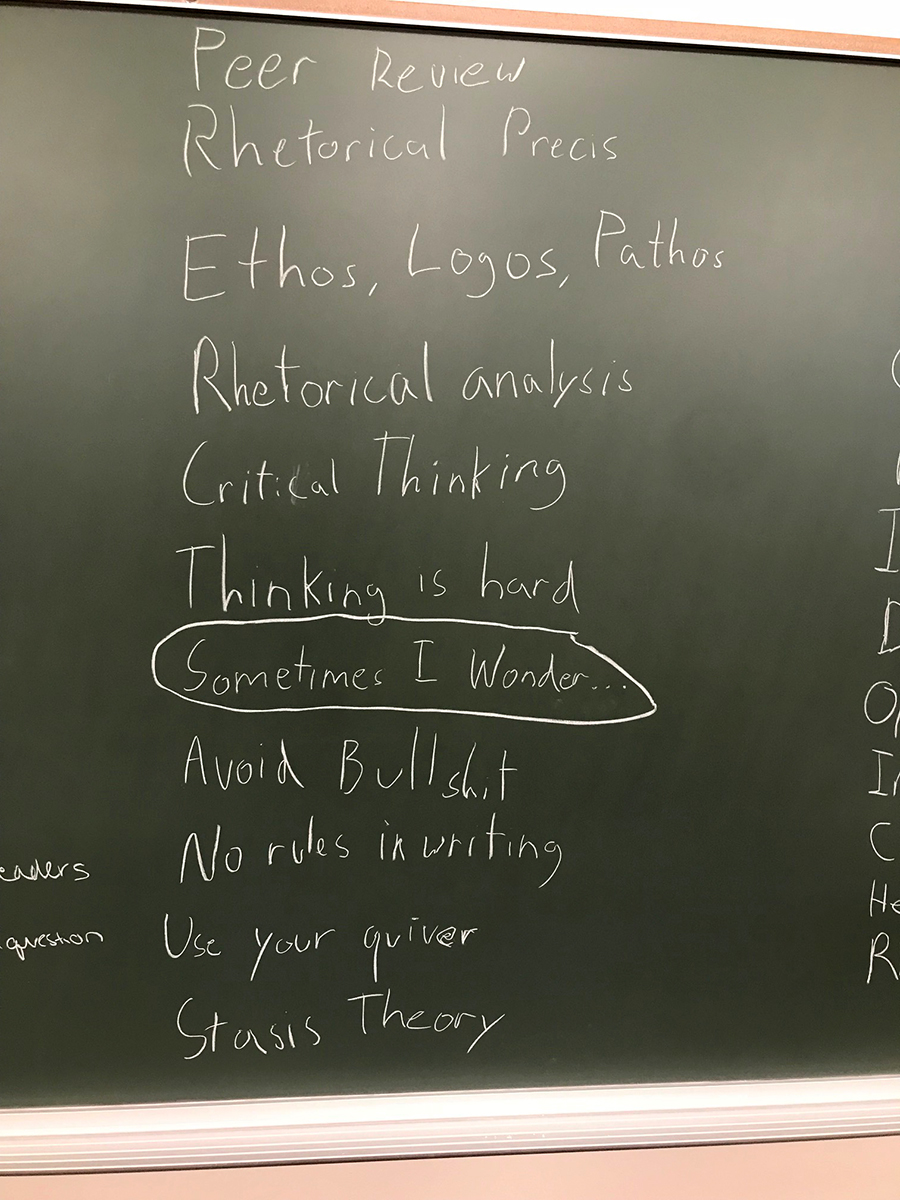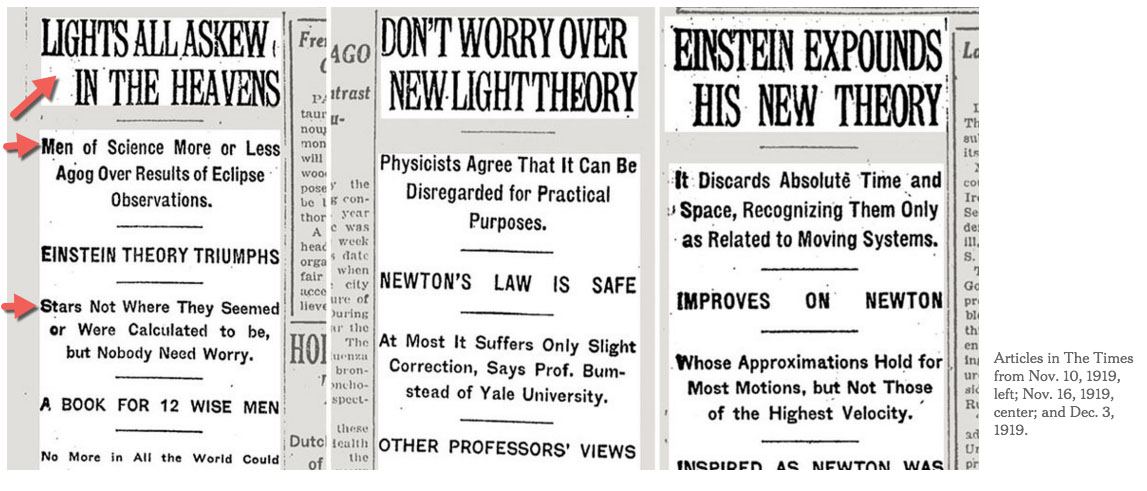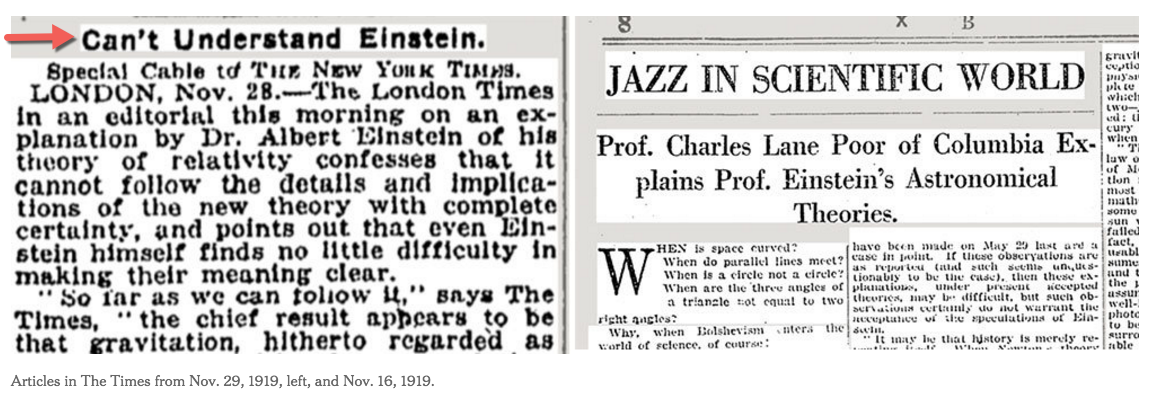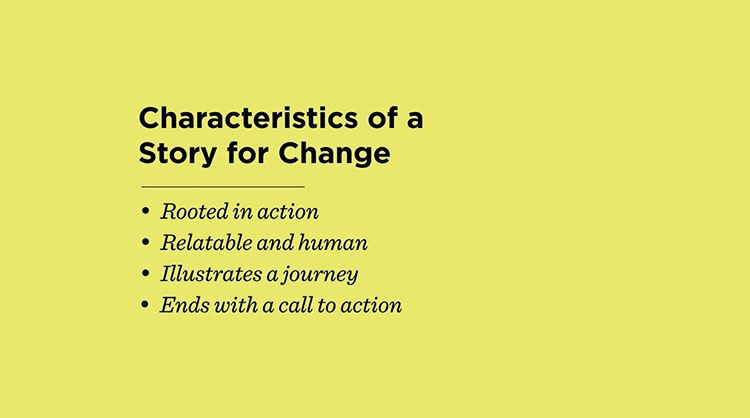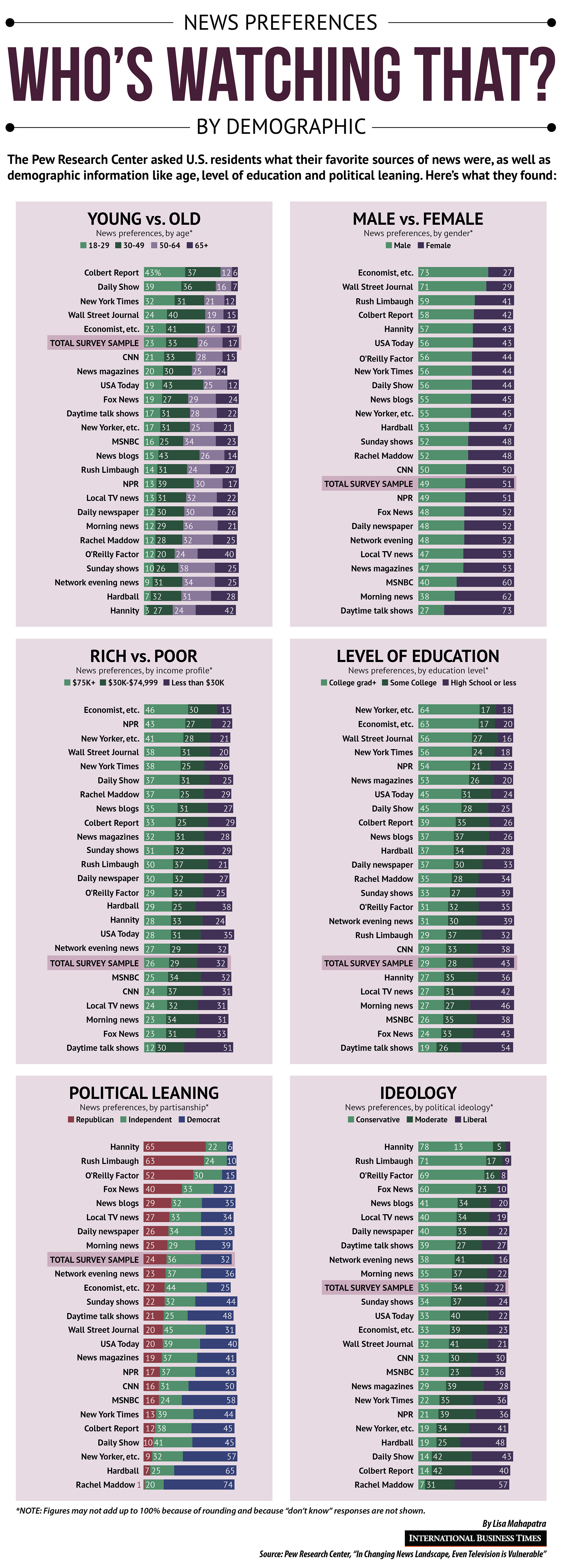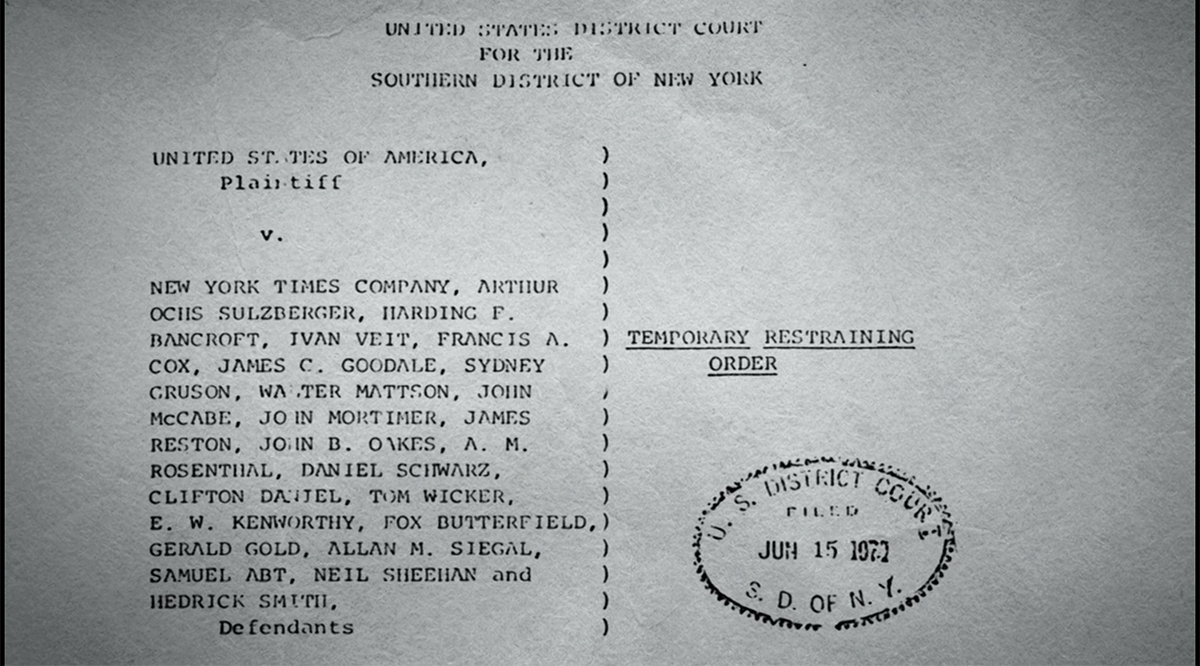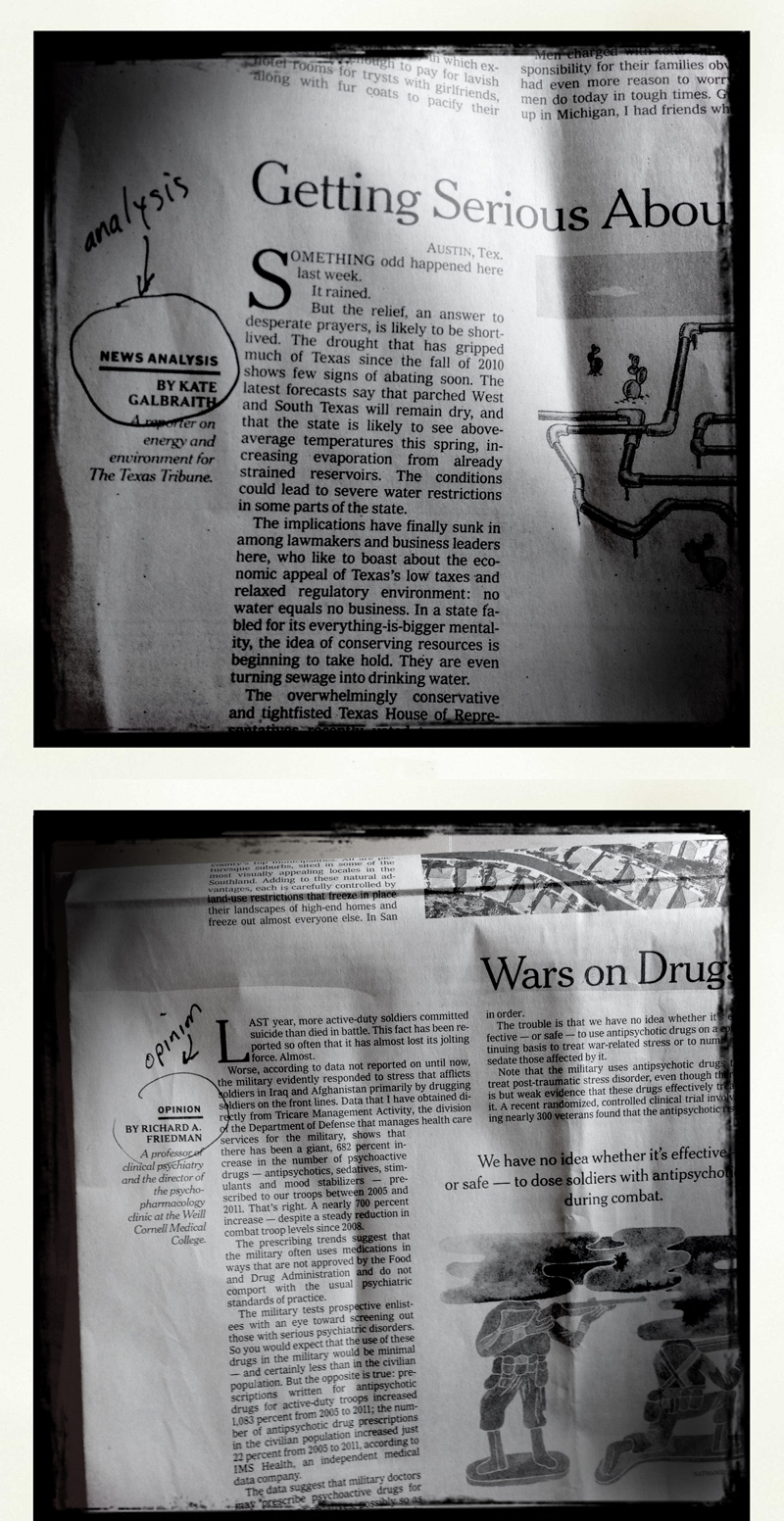
Three gatekeepers
November 12, 2018Congratulations, Daniel (9:40 section)!
Mr. Martinez's Letter to the Editor appears in the Monday, 11/12 Times, on the Editorial page:
Online version: "A Deamer Worries"
Congratulations, Claire (1:00): Op-Ed essay published in today’s DePaulia
Ms. Malon submitted her WRD 103 Op-Ed essay to the DePaulia's Opinions Editors and they accepted it immediately: "Even after #MeToo and #TimesUp, rape culture still thrives in the United States."
You'll see it in print later today, in all of the usual campus DePaulia distribution spots.
Congratulations, Claire — nicely done!
Concluding Thoughts
“One purpose of a liberal arts education is to make your head a more interesting place to live inside of for the rest of your life.” —Mary Patterson McPherson, President, Bryn Mawr College
“I thought that the future was a place—like Paris or the Arctic Circle. The supposition proved to be mistaken. The future turns out to be something that you make instead of find. It isn’t waiting for your arrival, either with an arrest warrant or a band; it doesn’t care how you come dressed or demand to see a ticket of admission. It’s no further away than the next sentence, the next best guess, the next sketch for the painting of a life’s portrait that may or may not become a masterpiece. The future is an empty canvas or a blank sheet of paper, and if you have the courage of your own thought and your own observation, you can make of it what you will.” —Lewis Lapham
“It ain’t where ya from, it’s where ya at!” —KRS-ONE, Ruminations

Congratulations, Ms. Williams (9:40 section)
Dara's Letter to the Editor appears in the Saturday 11/10 Times, on the Editorial page:

NYT/Williams: The School Bake Sale, Revisited

Congratulations, Ms. Arroyo (1:00 section)
Lizette's Letter to the Editor appears in the Friday 11/2 Times, on the Editorial page:
NYT/Arroyo: "A Caravan of Resilience"
Your course & portfolio brainstorming
“Lights all Askew in the Heavens … Men of Science More or Less Agog”
November 5, 2018They do.
November 3, 2018Another take on critical thinking
Good morning!
You are not immune to propaganda!
Your ‘side’ is not immune to spreading propaganda!
When you read things about social/political/whatever issues, step back and ask yourself: what does the reporting source want? What do they want me to think? What do they stand to gain by having me believe them? What kinds of counterpoints or alternate interpretations could there be? (And going 'only idiots/bigots/etc. would object’ and stopping is lazy, disingenuous, and drenched in Kool-Aid – dig deeper.)
Via Tumblr
Code and values

"The people who are closest to a thing are often the most wary of it. Technologists know how phones really work, and many have decided they don’t want their own children anywhere near them."
"A wariness that has been slowly brewing is turning into a regionwide consensus: The benefits of screens as a learning tool are overblown, and the risks for addiction and stunting development seem high. The debate in Silicon Valley now is about how much exposure to phones is O.K."
— NYT: "A Dark Consensus About Screens and Kids Begins to Emerge in Silicon Valley" — (“I am convinced the devil lives in our phones.”)
On the day we’re scheduled to discuss the Honduran caravan in our class on rhetoric …
… we get this from the NYT, p.A1, above the fold:

Notice how the headline changes in the online version:"How Trump-Fed Conspiracies About Migrant Caravan Intersect With Deadly Hatred"
We could probably get an entire class session just analyzig that one edit.
For Tuesday: Caravan Context & Inquiry
Shared reading for Tuesday: "The People of the Migrant Caravan" (SR 3) by Ioan Grillo.
- Grillo's Twitter: https://twitter.com/ioangrillo
- Grillo @ the NYT
- Grillo's home page
For background and self-educating: caravan context & inquiry
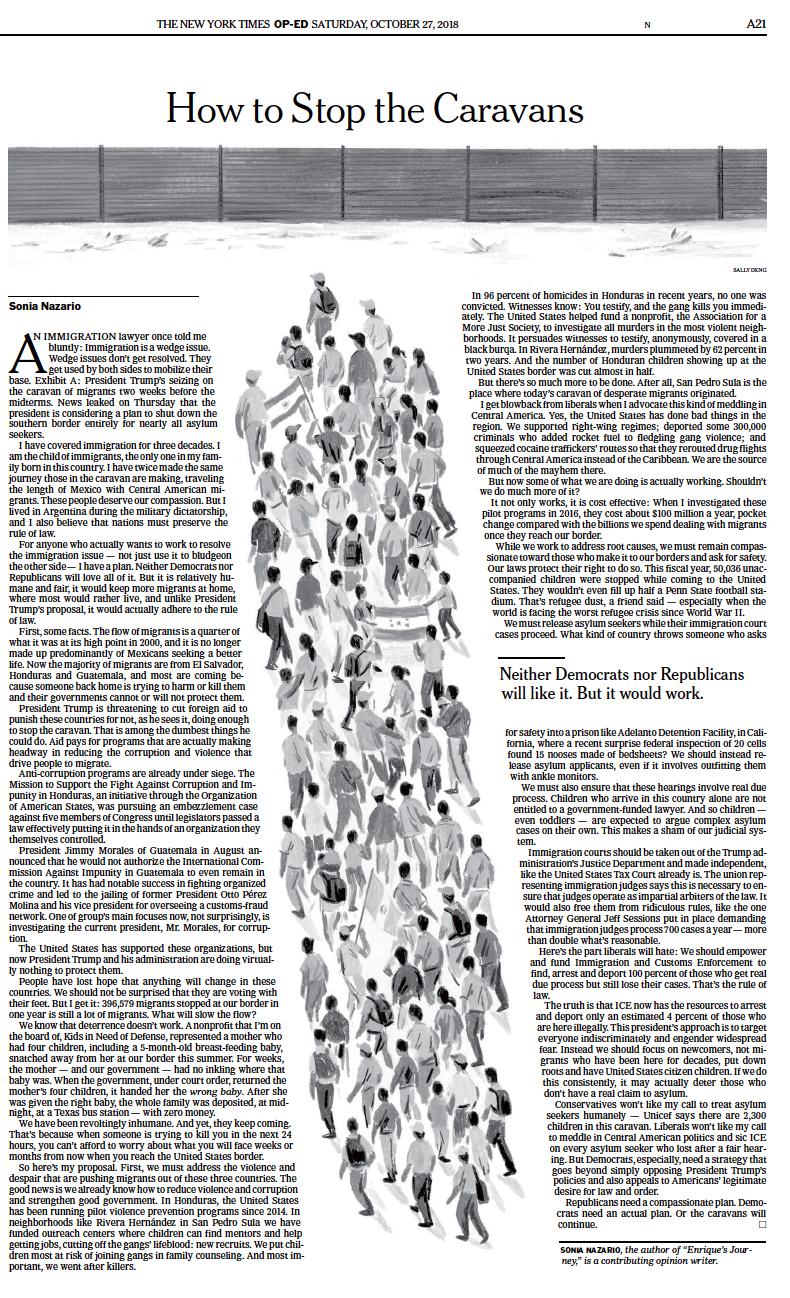
Nazario, "I’m a Child of Immigrants. And I Have a Plan to Fix Immigration." (Online version title)
- Times Reader Center: "Why The Times Is Covering the Caravan"
- #HondurasCaravan
Have any other resources I can or should add for Tuesday? Send them to me, please.
Commencement Speeches
David Foster Wallace’s Kenyon Commencement Speech (2005)
Intro
There are these two young fish swimming along and they happen to meet an older fish swimming the other way, who nods at them and says “Morning, boys. How’s the water?” And the two young fish swim on for a bit, and then eventually one of them looks over at the other and goes “What the hell is water?”
Transcript (PDF)
Audio (YouTube)
- Michelle Obama at Tuskegee; NYT coverage: “Michelle Obama Addresses Tuskegee University Graduates”
- Jon Lovett: 2013 Pitzer College Commencement Keynote — May 18, 2013. (On “bullshit.”)
- President Obama: Morehouse College Commencement Address.
- Steve Jobs Stanford Commencement Speech 2005.
- Ellen DeGeneres: Tulane’s 2009 Commencement Speech.
Jane Doe Ponytail typography
Hi Michael, I’m the designer for that story.
Normally NYT doesn’t indent paragraphs like that, but here I felt it was warranted given the story’s structure (it’s chapterized), length and tone. Vertical space between paragraphs (like on all web NYT articles) give stories a quick, punchy reading rhythm. In those articles all crucial information is absorbed into first three paragraphs or so. Indenting them (without vertical space) gives them a slower, more patient rhythm, like a novel. It’s uncommon, but again, I felt warranted in this case.
R. Taylor

NYT Letters to the Editor: Instructions and Conventions

Letters to the Editor:
- Procedure: How to
- Background: Tips for getting your letter published
- Successful examples from DePaul students
- Last names A-L: submit by Thursday 11/1
- Last names M-Z: submit by Tuesday 11/6
“Writing on the Wall”: newspapers, art & remix

"The newspaper is itself an outlandish creation: a smudgy, portable, disposable offline data platform made of tree pulp, mass-produced every day on huge printers and trucked for a fee to your home, or sold from the sidewalk. Newspapers are not the societal bulwark they once were; their authority is challenged and ubiquity is slipping. But artists who use and love newspapers do so for good reason.
"They are fountains of words, meaning, preliminary history. They are ready-made targets for irony, allusion and commentary, ripe for riffing and manipulation. They are beautiful in themselves, bursting with aesthetic riches — photographic and commercial art, comics, op-ed illustrations. They are also abundant, cheap and rectangular. And you can dip them in strips into flour and water and make beautiful things.
"Their place in art, as art, is honored and unshakable, which is reason enough to curse the glowing screens that are relentlessly shoving them aside.
— Downes, The Writing on the Wall
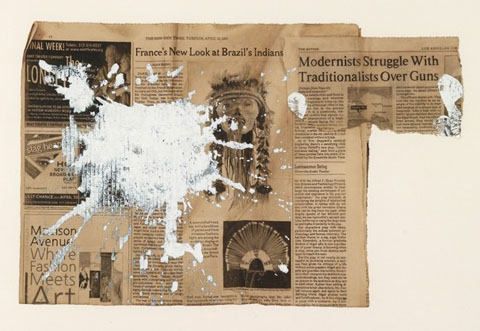
“Writing on the Wall”: newspapers, art & remix
"Shock of the News"
- NYT review: "Recycled Newsprint ‘Shock of the News,’ on Artists and Newspapers" (Sunday Book Review).
- Via the National Gallery.
- Making art from newspapers.
“Newspapers are still with us, but the public role of at least the printed version is greatly diminished. We have effectively left the era of the printed page in which newspapers covered the land like rain. Yet, as the world becomes increasingly virtual and digital, newspapers take on an expanded role in our imaginations.”
“This exhibition will focus on currently working artists whose engagement with the material and content of newspapers gives us a window on its changing status. All of the artists grew up with newspapers as quotidian objects. They are perhaps the last generation to do so.”
![]()
Another way to contextualize and to think about critical thinking?
d. Making Proper Use of Impressions
"Neither desire nor aversion, but sense impressions."
Do not allow yourself to be carried away by [the] intensity of your impression: but say, 'Impression, wait for me a little. Let me see what you are, and what you represent. Let me test you. Let me spend some time with you.'" Then, afterwards, do not allow it to draw you on by picturing what may come next, for if you do, it will lead you wherever it pleases. But rather, you should introduce some fair and noble impression to replace it, and banish this base and sordid one.
(Discourses 2.18.24–5, trans. Hard)
Encylopedia of Philosophy
Time Management
We can spend some classtime on this if you'd like.
Until then:
- 7 Time Management Tips for Finals Week
- Time Management Tips (via Dartmouth)
- Time Management Planner (via DePaul CSH)
Another way into persuasive writing
October 17, 2018Print/digital followup: the day planner example
October 16, 2018Some differences between print & digital composing
There are some conventions in digital writing that are different than in writing for print:
- We use serif fonts for body text — Georgia, say — and sans serif for subject headings
- We don't indent the first sentence in new paragraphs
- But we do provide white space between paragraphs
- Lines of text contain 11-14 words for readability
- We use blue and underlined links
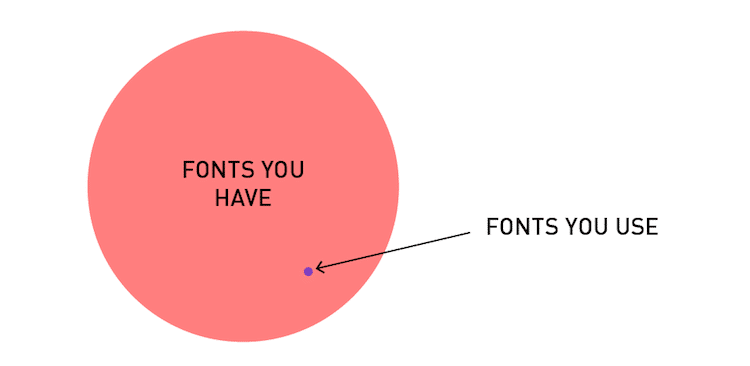
Moral Politics: How Liberals and Conservatives Think
From George Lakoff, Moral Politics: How Liberals and Conservatives Think (U of Chicago Press)
Here are some words and phrases used over and over in conservative discourse: character, virtue, discipline, tough it out, get tough, tough love, strong, self-reliance, individual responsibility, backbone, standards, authority, heritage, competition, earn, hard work, enterprise, property rights, reward, freedom, intrusion, interference, meddling, punishment, human nature, traditional, common sense, dependency, self-indulgent, elite, quotas, breakdown, corrupt, decay, rot, degenerate, deviant, lifestyle.
The same, of course, is true of the liberal worldview. Liberals, in their speeches and writings, choose different topics, different words, and different modes of inference than conservatives. Liberals talk about: social forces, social responsibility, free expression, human rights, equal rights, concern, care, help, health, safety, nutrition, basic human dignity, oppression, diversity, deprivation, alienation, big corporations, corporate welfare, ecology, ecosystem, biodiversity, pollution, and so on. Conservatives tend not to dwell on these topics, or to use these words as part of their normal political discourse. A description of the liberal and conservative worldviews should explain why.
Probably just bullshit
October 10, 2018Purposes for Arguing, Persuading, and Advocating
Arguing to convince: claim + support
More often than not, out-and-out defeat of another is not only unrealistic but also undesirable. Rather, the goal is to convince other persons that they should change their minds about an issue. A writer must provide reasons so compelling that the audience willingly agrees with the writer’s conclusion. Such is the goal of advocates of assisted suicide: they well know that they cannot realistically hope to defeat or conquer those who oppose such acts. Rather, they understand that they must provide reasons compelling enough to change people’s minds.
Arguing to understand: stasis & truth seeking
Often, a writer must enter into conversation with others and collaborate in seeking the best possible understanding of a problem, exploring all possible approaches and choosing the best alternative. The Rogerian and invitational forms of argument both call for understanding as a major goal of arguing. Argument to understand does not seek to conquer or control others or even to convince them. Your purpose in many situations—from trying to decide which job to pursue to exploring with your family the best way to care for an elderly relative—will be to share information and perspectives in order to make informed political, professional, and personal choices.
Arguing to change yourself: Exploratory Essay
Sometimes you will find yourself arguing primarily with yourself, and those arguments often take the form of intense meditations on a theme, or even of prayer. In such cases, you may be hoping to transform something in yourself or to reach peace of mind on a troubling subject. If you know a familiar mantra or prayer, for example, think of what it “argues” for and how it uses quiet meditation to help achieve that goal.
![]()
“But, as we’ve already suggested [invitational rhetoric], arguing isn’t always about winning or even about changing others’ views. In addition to invitational argument, another school of argument-called Rogerian argument, after the psychotherapist Carl Rogers-is based on finding common ground and establishing trust among those who disagree about issues, and on approaching audiences in nonthreatening ways. Writers who follow Rogerian approaches seek to understand the perspectives of those with whom they disagree, looking for “both/and” or “win/win” solutions (rather than “either/or” or “win/lose” ones) whenever possible. Much successful argument today follows such principles, consciously or not.”
— From Andrea Lunsford, Everyone’s an Author
Possible Prompt for your Op-Ed Essay?
October 8, 2018Sunday Review, P1
October 7, 2018Paragraph development and transitions
[P] Every wolf in Yellowstone therefore is more than just a wolf. Imbued with profound symbolic meaning, each wolf embodies the divergent goals of competing social movements involved in the reintroduction debate. Framed by environmentalists and their wise use opponents as another line in the sand in their ongoing battle for the heart and soul of the West, wolf reintroduction is a high-stakes political conflict. [I] Wolf recovery is often portrayed by environmentalists as being symptomatic of a culture in transition–an inevitable change (Askins, 1995). It is an image that plays especially well with the media: “[T]he wolf issue pits the New West against the Old West” (Johnson, 1994, p. 12), a milestone in the “transformation of power” from the Old West (Brandon, 1995, p.8). [E] Wolf restoration clearly represents change, but sound bites that reduce the social struggle over wolves to an “inevitable” transition from the old to the new are inadequate. They do not explain the underlying social issues driving the transformation. They do not capture the essence of social negotiation, the give-and-take of political exchange between social movements struggling to define the western landscape. Nor do they acknowledge that these social issues will remain after the wolf controversy has exited the center stage of public policy discourse.
Wilson, Matthew. “The Wolf in Yellowstone: Science, Symbol, or Politics? Deconstructing the Conflict between Environmentalism and Wise Use.” Society & Natural Resources. 10(1997): 453-468. (more…)
Identifying issues & asking pertinent questions
Here are my informal notes from the session where we tried to identify the real, actual, genuine issues surrounding the Judge Kavanaugh nomination hearings. I’ve done some paraphrasing and combining, so let me know if you see any errors or if I missed anything, pretty-please? This is the work of stasis theory and practice — finding common ground by asking pertinent questions:
- Sexual assault — every state has their own law; here’s Illinois
- The “boys will be boys” problem (mostly a culture & sociological problem?)
- What counts as credible? Who gets to decide credibility issues?
- Politics, where some politicians use the issue for ideological purposes — to score ideological points (a potential source of cynicism for readers and citizens)
- The role of President Trump — appropriate to combine with above?
- The roles and integrity of the Supreme Court and other civic institutions
- The challenge of precision/clarity in historic cases, especially as they play out in contemporary real time
- White male privilege and associated social norms
Rhetoric isn’t limited to the Op-Ed pages

NYT: 8 Questions About Social Security Answered as Election Day Nears
“Every two years, voters — whether they already count on the program, expect to or question paying into it — try to make sense of competing claims about it. It’s that time again.”
Who is reading and watching by ideological positions & demographic
September 28, 2018Op-Ed art & illustration

… “himpathy” — the inappropriate and disproportionate sympathy powerful men often enjoy in cases of sexual assault, intimate partner violence, homicide and other misogynistic behavior.” — Manne, 09/27/18.
— Illustration by Colleen Tighe — a regular NYT contributor.
— Also see Op-Ed Art at 40: A Brief History of the Art
Rhetoric of Silence
Defining Civil Discourse
… discourse that is civil means that those involved,
- undertake a serious exchange of views;
- focus on the issues rather than on the individual(s) espousing them;
- defend their interpretations using verified information;
- thoughtfully listen to what others say;
- seek the sources of disagreements and points of common purpose;
- embody open-mindedness and a willingness change their minds;
- assume they will need to compromise and are willing to do so;
- treat the ideas of others with respect;
- avoid violence (physical, emotional, and verbal).
— AACU: “A Plea for Civil Discourse: Needed, the Academy’s Leadership”
Lens: photography section & blog
September 23, 2018Michelle Alexander’s Sunday Review Essay
It’s still early Saturday morning, and Ms. Alexander already has 593 reader comments posted to her Sunday Review Essay …

Michelle Alexander: “We Are Not the Resistance”
Print version:

“Let Teenagers Sleep In”

“Three out of every four students in grades 9 to 12 fail to sleep the minimum of eight hours that the American Academy of Sleep Medicine recommends for their age group. And sleep deprivation is unremittingly bad news. At its most basic, insufficient sleep results in reduced attention and impaired memory, hindering student progress and lowering grades. More alarmingly, sleep deprivation is likely to lead to mood and emotional problems, increasing the risk of mental illness. Chronic sleep deprivation is also a major risk factor for obesity, Type 2 diabetes, hypertension, cardiovascular disease and cancer. As if this weren’t enough, it also makes falling asleep at the wheel much more likely.”
“It is important to understand why teenagers have a particularly hard time getting enough sleep, and what adults need to do to help.”
NYT/Nicholls: “Let Teenagers Sleep In”
Oxford English Dictionary (OED)
1. The method or process of printing in which a solid plate of type-metal, cast from a papier-mâché or plaster mould taken from the surface of a forme of type, is used for printing from instead of the forme itself.
“stereotype, n. and adj.” OED Online, Oxford University Press, July 2018, www.oed.com/view/Entry/189956. Accessed 8 September 2018.
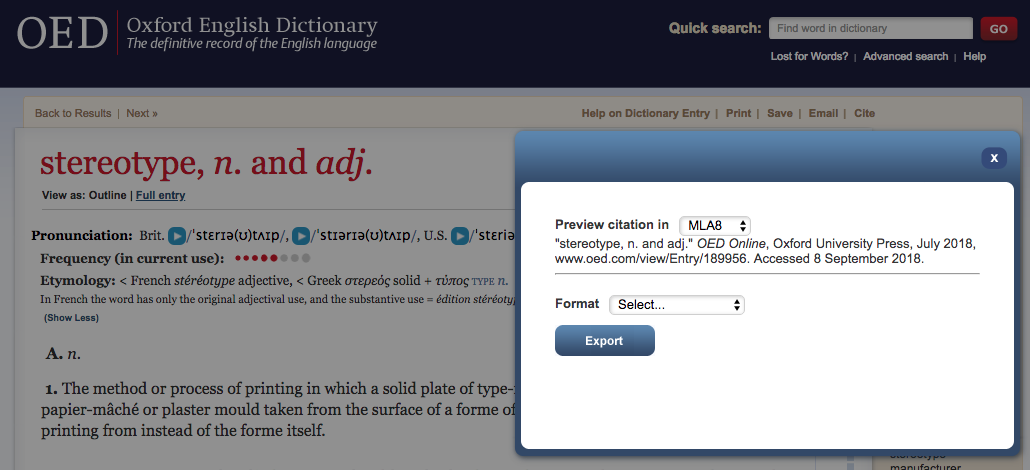
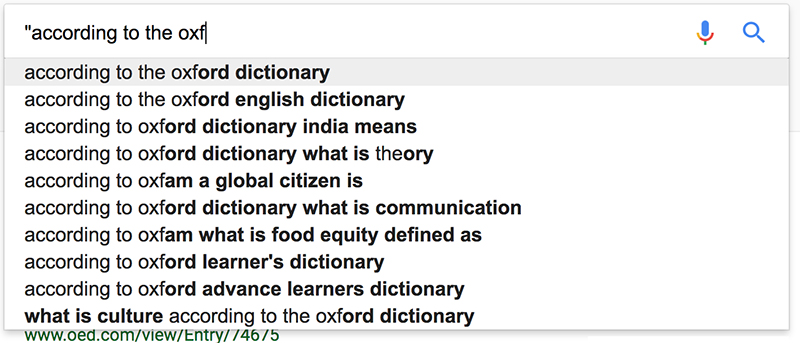

Page One
Prep for viewing Page One: A Year Inside the New York Times:
Pentagon Papers: highly classified and top-secret papers collected and distributed by Daniel Ellsberg to expose the government’s misleading American citizens about the Vietnam War (1971)
Wikileaks: publishes anonymously sourced and classified materials — the Pentagon Papers of the 21st-century, so to speak, except that it’s on the internet and relentless. The Pentagon Papers happened only once, whereas Wikileaks happens every day.
David Carr, NYT Media Writer
- The article that Carr is working on during the filming of the documentary: At Sam Zell’s Tribune, Tales of a Bankrupt Culture
- Carr’s obituary: David Carr, Times Critic and Champion of Media, Dies at 58 — January 2015
Brian Stelter, Media Writer now works at CNN
Tim Arango, NYT Reporter: now a Los Angeles correspondent for the Times after seven years in Iraq.
Analysis & Opinion
September 11, 2018Mexico City, 1968
“Mexico City, Oct. 18–The United States Olympic Committee suspended Tommie Smith and John Carlos today for having used last Wednesday’s victory ceremony for the 200- meter dash at the Olympic Games as the vehicle for a black power demonstration.”
“The two Negro sprinters were told by Douglas F. Roby, the president of the committee, that they must leave the Olympic Village. Their credentials also were taken away, which made it mandatory for them to leave Mexico within 48 hours.”
“2 Black Power Advocates Ousted From Olympics”
Page A1, but the photo did not accompany the article:
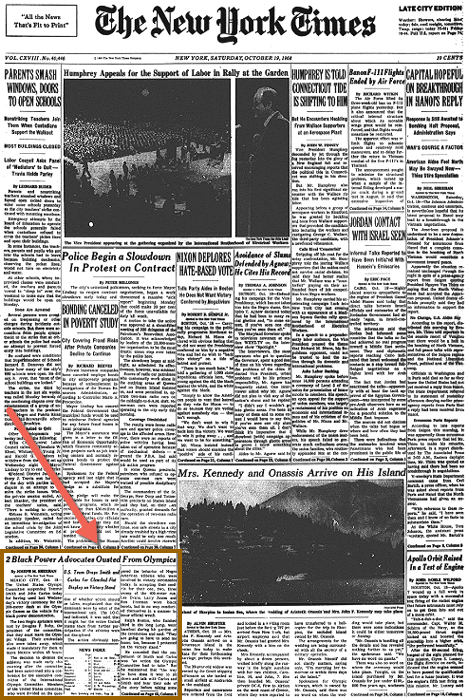
“Then, late in the Games, Smith and Carlos came up with their almost impromptu plan for the silent scream of those raised fists. The American news media were brutal. At home, most blacks smiled; most whites smoldered. Shortly after the protest, Smith told the ABC commentator Howard Cosell: “The right glove that I wore on my right hand signified the power within black America. The left glove my teammate John Carlos wore on his left hand made an arc with my right hand and his left hand, also to signify black unity. The scarf that was worn around my neck signified blackness. John Carlos and me wore socks, black socks, without shoes, to also signify our poverty.”
“The two medalists were soon kicked off the team, and as Hoffer reveals, that was only a prelude to death threats and more. “Nothing either would say was really registering,” Hoffer writes. “They had, in almost total spontaneity, created a scene of discontent that was so powerful that words would always fail it.” Again and again, they “tried to explain their symbols of protest, their furious pose, but the words piled up uselessly against the image they’d created.” For years to come, both Carlos and Smith would pay mightily for their galvanizing gesture. It derailed their athletic careers and apparently helped to end their marriages.”
NYT Sunday Book Review: Marino, 2009, “One Moment in Time”
Welcome to WRD103: Rhetoric & Composition I
Autumn Quarter, 2018
Great minds discuss ideas.
Average minds discuss events.
Small minds discuss people.
— Eleanor Roosevelt
“The test of a first-rate intelligence is the ability to hold two opposing ideas in mind at the same time and still retain the ability to function.” —F. Scott Fitzgerald
WRD 103 introduces you to the forms, methods, expectations, and conventions of college-level academic writing. We also explore and discuss how writing and rhetoric create a contingent relationship between writers, readers, and issues, and how this relationship affects the drafting, revising, and editing of our written — and increasingly digital and multimodal — projects.
In WRD 103, we will:
- Gain experience reading and writing in multiple genres in multiple modes
- Practice writing in different rhetorical circumstances, marshaling sufficient, plausible support for your arguments and advocacy positions
- Practice shaping the language of written and multimodal discourses to your audiences and purposes, fostering clarity and emphasis by providing explicit and appropriate cues to the main purpose of your texts
- Practice reading and evaluating the writing of others in order to identify the rhetorical strategies at work in written and in multimodal texts.
You’ll be happy to note, I hope, that we build on your previous knowledge and experiences; that is, we don’t assume that you show up here a blank slate. We assume that you have encountered interesting people, have engaging ideas, and have something to say. A good writing course should prepare you to take those productive ideas into other courses and out into the world, where they belong, and where you can defend them and advocate for them.
Finally, it’s no secret around here that students who take early and regular advantage of DePaul’s Center for Writing-based Learning not only do better in their classes, but also benefit from the interactions with the tutors and staff in the Center.
![]()
Habits of Mind
Habits of mind refers to ways of approaching learning that are both intellectual and practical and that will support your success in a variety of fields and disciplines. The framework identifies eight habits of mind essential for success in college writing
|
